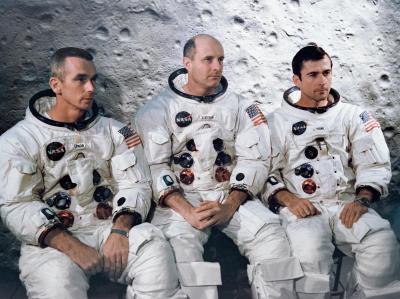 The Apollo 10 crew, credited as the fastest people in history. How a scientist would talk about being the "fastest" became a sticking point in writing The Martian, as discussed in one of the pieces we read this week.
The Apollo 10 crew, credited as the fastest people in history. How a scientist would talk about being the "fastest" became a sticking point in writing The Martian, as discussed in one of the pieces we read this week.NCSE moved offices this week, which left less time than usual for reading. But the fact that all our books and computers are in boxes didn't keep me or my colleagues from getting caught up in some good reads.
- “The Toughest Scene I Wrote: How Drew Goddard Made Physics Fun in The Martian.” Vulture, January 26, 2016 — Kevin Lincoln talked with Drew Goddard, screenwriter for The Martian, about the challenge of getting the science right in a Hollywood blockbuster. In the end, the toughest scene to write was solved not by fighting the way scientists talk and nitpick, but by building it right into the script. It’s exactly the sort of thing Randy Olsen would’ve written, exploring the interplay between good storytelling and good science.
- Accepting, Understanding, Teaching, and Learning (Human) Evolution: Obstacles and Opportunities, American Journal of Physical Anthropology, January 2016 — A fantastic review article by Briana Pobiner on the pedagogy of human evolution. She concludes, "Despite the potentially controversial topic of human evolution, growing research is demonstrating that a pedagogical focus on human examples is an effective and engaging way to teach core concepts of evolutionary biology."
- "We're the Only Animals with Chins, and No One Knows Why," The Atlantic, January 28, 2016 — Of all animals extinct or extant, only humans have chins. What do we have them for? What selective pressure resulted in the chin? Was it that we constantly punched each other in the face? This delightful article explores and tentatively rejects this and other hypotheses for why humans have chins. (We also read Yong's follow-up, which emphasizes that "No, Really, Other Animals Don't Have Chins.")
- "Climate Deal’s First Big Hurdle: The Draw of Cheap Oil," The New York Times, January 25, 2016 — Considering the prospects for the Paris climate deal, the Times reports that falling gasoline prices could sink the deal.
- "The Zika virus foreshadows our dystopian climate future," The Guardian, January 25, 2016 — Bill McKibben explains how the consequences of Zika virus are, like so many other climate change related phenomena, such as smog and sea level rise, disproportionately affecting poor countries. It is a stark and important reminder that out of sight should not be out of mind.
- "To Lions, Zebras Look Mostly Gray…So Why Are They Stripey?," The Atlantic, January 26, 2016 — In his usual delightful way, Ed Yong explains new research that suggest the old “they’re striped so they confuse lions” theory is not valid (note: it’s also teleological!). The new hypothesis is that stripes defend against disease-carrying biting flies. But as with everything in science, it might not be that simple, there is some evidence that at least one other selection pressure is at play, too.
- "Sitting Ducks: Why Millions of Arctic Seabirds Are in Danger," Audubon, January-February 2016 — "Scientists worry that seabirds are especially sensitive to the threats of climate change, ocean acidification, commercial fishing, and shifts in marine ecosystems—threats that are only expected to intensify in the coming years," writes Scott Weidensaul.

